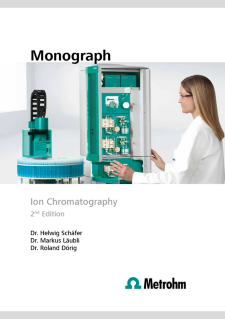[1] Kromidas, S. The HPLC Expert; Wiley-VCH: Weinheim, 2016.
[2] Haddad, P. R.; Jackson, P. E. Ion Chromatography; Journal of Chromatography Library; Elsevier: Amsterdam, 1990.
[3] Schäfer, H.; Läubli, M. Monograph: Ion Chromatography; Metrohm AG: Herisau, Switzerland, 2023. https://www.metrohm.com/en/products/8/1085/81085077.html
[4] Liu, Y.; Kaiser, E.; Avdalovic, N. Determination of Trace-Level Anions in High-Purity Water Samples by Ion Chromatography with an Automated On-Line Eluent Generation System. Microchemical Journal 1999, 62 (1), 164–173. DOI:10.1006/mchj.1999.1699
[5] Zou, J.; Motomizu, S.; Fukutomi, H. Reversed-Phase Ion-Interaction Chromatography of Inorganic Anions with Tetraalkylammonium Ions and Divalent Organic Anions Using Indirect Photometric Detection. Analyst 1991, 116 (12), 1399–1405. DOI:10.1039/AN9911601399
[6] Wahab, M. F.; Anderson, J. K.; Abdelrady, M.; et al. A. Peak Distortion Effects in Analytical Ion Chromatography. Anal. Chem. 2014, 86 (1), 559–566. DOI:10.1021/ac402624a
[7] Martin, D. Column Chromatography; IntechOpen, 2013.
[8] Motomizu, S.; Oshima, M.; Hironaka, T. Ion-Exchange Chromatographic Determination of Anions by Indirect Photometric Detection: Comparison of Eluent Ions with Respect to Sensitivity Enhancement. Analyst 1991, 116 (7), 695–700. DOI:10.1039/AN9911600695
[9] Acikara, Ö. B. Ion-Exchange Chromatography and Its Applications. From the Edited Volume Column Chromatography, Edited by Dean F. Martin and Barbara B. Martin, InterOpen 2013. DOI:10.5772/55744
[10] Metrohm AG. Column Manual A Supp 19 (6.01034.4x0); 8.107.8013EN / 2023-03-08; Metrohm AG: Herisau, Switzerland, 2023.
[11] Kolb, M.; Seubert, A.; Schäfer, H.; Läubli, M. (Editor). Monograph: Practical Ion Chromatography, 3rd ed.; Metrohm AG: Herisau, Switzerland, 2020. https://www.metrohm.com/en/products/8/1085/81085069.html
 Sdílet článek
Sdílet článek

